 W
WUsed in television production and filmmaking post-production, a 2-pop is a 1 kHz tone that is one frame long and placed 2 seconds before the start of program. It is a simple and effective method of ensuring synchronization between sound and picture in a video or film.
 W
W2K resolution is a generic term for display devices or content having horizontal resolution of approximately 2,000 pixels. In the movie projection industry, Digital Cinema Initiatives is the dominant standard for 2K output and defines 2K resolution as 2048 × 1080.
 W
WThe Amiga video connector is a 23-pin male D-subminiature connector fitted to all personal computers in the Amiga range produced by Commodore International from 1985 to 1994, and by Escom from 1995 to 1996. The connector carries signals for analogue and digital RGB, RGB intensity, and genlocking as well as power. Default Amiga screenmodes are directly compatible with TVs in the region in which the computer was sold, so that the user could connect the computer to a common TV if no monitor was available. In the PAL region, the Amiga could be connected directly to the standardized SCART RGB connector on the TV via an adapter cable sold by Commodore, providing superior image quality. Alternatively, Commodore sold an adapter, that attached to the Amiga video connector and provided composite and RF outputs appropriate to the region in which it was sold. Commodore also sold a range of monitors, which were compatible with the TV signals of the region in which they were sold, and in the PAL region many even had SCART inputs so that not only Amigas, but also other SCART-compatible equipment could be attached to them.
 W
WArriflex 416 is a motion picture camera product line created by Arri in 2006. This camera line was introduced in large part to accommodate new lenses of larger diameter that physically interfered with the Arri 16 SR3 viewfinder. The 416 camera series is designed for 16mm filmmaking in the Super 16 format. The 416 series has some features that are derived from Arri's 35mm cameras. The 416 series is compatible with some 35mm camera accessories, such as PL-mount lenses, base plates, matte boxes, follow focus units, and more.
 W
WThe Arriflex 535 is a movie camera product line created by Arri in 1990 to replace the Arriflex 35 BL line.
 W
WThe Arriflex D-21 is a film-style digital motion picture camera introduced by Arri in 2008 to replace their earlier generation Arriflex D-20.
 W
WThe Bioscop is a movie projector developed in 1895 by German inventors and filmmakers Max Skladanowsky and his brother Emil Skladanowsky (1866–1945).
 W
WThe Brenkert Brenograph Jr. was a projector used in atmospheric theatres to project moving clouds over ceilings painted blue. The effect created the illusion that theatre patrons were outdoors. The device was used primarily in theatre designs of John Eberson.
 W
WA camera stabilizer, or camera–stabilizing mount, is a device designed to hold a camera in a manner that prevents or compensates for unwanted camera movement, such as "camera shake".
 W
WThe Chronophone is an apparatus patented by Léon Gaumont in 1902 to synchronise the Cinématographe (Chrono-Bioscope) with a disc Phonograph (Cyclophone) using a "Conductor" or "Switchboard". This sound-on-disc display was used as an experiment from 1902 to 1910. In January 1911, the industrial exploitation started at the Olympia. Chronophone would show Phonoscènes and films parlants almost every week from 1911 until 1917 at the Gaumont Palace, "the Greatest Cinema Theatre in the World", previously known as the Paris Hippodrome.
 W
WCinéorama was an early film experiment and amusement ride presented for the first time at the 1900 Paris Exposition. It was invented by Raoul Grimoin-Sanson and it simulated a ride in a hot air balloon over Paris. It represented a union of the earlier technology of panoramic paintings and the recently invented technology of cinema. It worked by means of a circulatory screen that projects images helped by ten synchronized projectors.
 W
WCinetrain or cine-train was a documentary film project conducted across the Soviet Union in the late 1920s by director Aleksandr Medvedkin. All 60 films created in Cinetrain were considered lost until 1980, when some of them were discovered in the archives of film historian Nikolai Izvolov.
 W
WThe CP-16, CP-16A, CP-16R, CP-16R/A and CP-16R/DS cameras are 16mm motion picture cameras manufactured by the Cinema Products Corporation of Hollywood, California. A range of cameras of Auricon ancestry. They were primarily intended for television news filming and were quite popular with local and national news agencies before the advent of portable videotape Electronic News Gathering, (ENG) formats, as well as documentary and drama production.
 W
WA D-mount is a type of lens mount commonly found on 8mm movie cameras.
 W
WDefinity is a digital film recorder for motion picture applications, produced by CCG Digital Image Technology, the successor of Agfa-Gevaert's film recorder division.
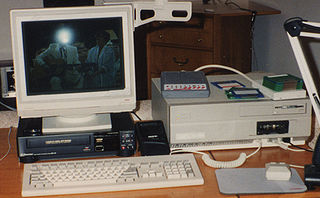 W
WDesktop video refers to a phenomenon lasting from the mid-1980s to the early 1990s when the graphics capabilities of personal computers such as Commodore's Amiga, the Apple Macintosh II and specially-upgraded IBM PC compatibles had advanced to the point where individuals and local broadcasters could use them for analog non-linear editing (NLE) and vision mixing in video production. Despite the use of computers, desktop video should not be confused with digital video since the video data remained analog. Full-screen, full-motion video's vast storage requirements meant that the promise of digital encoding would not be realized on desktop computers for at least another decade.
 W
WDolby 3D is a marketing name for a system from Dolby Laboratories, Inc. to show three-dimensional motion pictures in a digital cinema.
 W
WThe Dolby SR noise reduction format was developed by Dolby Laboratories and has been in common use in professional audio since 1986 and in cinema audio since the late 1980s. It is a revised version of Dolby's earlier formats, combining aspects of Dolby A, B and C to improve the dynamic range of analogue recordings and transmissions by as much as 25 dB.
 W
WAn EcoDisc is a patented type of DVD which is thinner than a conventional DVD because it is made from a single layer of polycarbonate instead of two layers glued together. Because it contains less material, its manufacture produces only around half of the carbon dioxide of a conventional DVD, and the absence of a non-biodegradable toxic glue layer makes it easier to recycle. Ecodiscs are prone to breakage since they are, as of May 2011, much less stiff than regular discs.
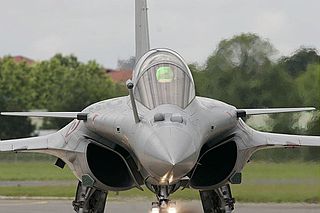 W
WAn electro-optical targeting system (EOTS), is a system employed to track and locate targets in aerial warfare. It can use charge-coupled device TV cameras, laser rangefinders and laser designators.
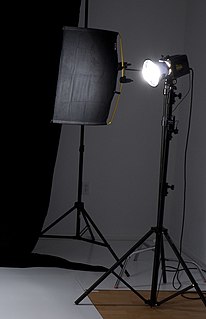 W
WA flag is a device used in lighting for motion picture and still photography to block light. It can be used to cast a shadow, provide negative fill, or protect the lens from a flare. Its usage is generally dictated by the director of photography, but the responsibility for placing them can vary by region, usually devolving to either the gaffer and electricians or the key grip and lighting grips.
 W
WThe Frazier lens is a special camera lens designed by Australian photographer Jim Frazier. The Frazier lens provides an appearance of a massive depth of field, allowing the foreground and background of an image to be in focus. Frazier's lenses have been widely used in Hollywood and wildlife cinematography. In addition to its unique depth of field properties, the Frazier lens is significantly smaller than previous deep focus lenses allowing more versatility and flexibility to cinematographers. The main feature of the lens, an extended tube with a rotating prism, allows cinematographers to place the camera in a variety of positions for a given shot. Cinematographers then rotate the prism to correct the horizon. This feature allows directors and cameramen to achieve shots in minutes that previously took cinematographers hours in rigging and designing special sets to accommodate shooting positions.
 W
WThe Sony Glasstron was a family of portable head-mounted displays, first released in 1996 with the model PLM-50. The products included two LCD screens and two earphones for video and audio respectively. These products are no longer manufactured nor supported by Sony.
 W
WThe term IMAG is a short form for "image magnification" used in the audiovisual production industry. It refers to large-scale theatrical or concert video projection to enable audience members seated at great distance from the stage to see details of the performer's body language and facial expressions that could not be seen with the unaided eye.
 W
WAn inflatable movie screen is an inflatable framework with an attached projection screen. Inflatable screens are used for outdoor movies, film festivals, drive-in theaters, sports, social, fundraising and other events requiring outdoor projection.
 W
WIn cinematography, a jib is any boom device used to mount a camera on one end, and a counterweight with camera controls on the other. In principle, it operates like a see-saw, with the balance point located closer to the counterweight, which allows the end of the arm with the camera to move through an extended arc. Typically a jib permits the camera to be moved vertically, horizontally, or a combination of the two. A small jib can be mounted on a tripod, but many larger, purpose-built jibs have their own support stands, often on wheels. Modern jibs are normally modular and can be assembled in various lengths.
 W
WThe Kaiserpanorama is a form of stereoscopic entertainment medium used chiefly in the 19th and early 20th centuries, a precursor to film, invented by August Fuhrmann (1844–1925). It was patented by the inventor ca. 1890. There would be a number of viewing stations through which people would peer through a pair of lenses showing a number of rotating stereoscopic glass slides. By 1910 he is said to have controlled exhibitions in over 250 branches across Europe, and in the central archive have up to 100,000 slides stored.
 W
WThe Kinora was an early motion picture device. It was developed by the French inventors Auguste and Louis Lumière in 1895, while simultaneously working on the Cinematograph. It was patented in February 1896.
 W
WKodascope is a name created by Eastman Kodak Company for the projector it placed on the market in 1923 as part of the first 16mm motion picture equipment. The original Kodascope was part of an outfit that included the Cine-Kodak camera, tripod, Kodascope projector, projection screen, and film splicer, all of which sold together for $335. By 1924, Victor Animatograph Corporation and Bell and Howell had placed 16mm projectors on the market, so Kodak eliminated the requirement to purchase the equipment as a complete outfit and sold the projector separately. Kodascope was retained as the primary marketing name for 16mm projectors throughout their production life at Kodak.
 W
WThe Krasnogorsk-3 (Красногорск-3) was a spring-wound 16mm mirror-reflex movie camera designed and manufactured in the USSR by KMZ. A total of 105,435 Krasnogorsk-3 cameras were produced between 1971 and 1993.
 W
WLaserfilm was a videodisc format developed by McDonnell-Douglas in 1984 that was a transmissive laser-based playback medium.
 W
WThe Latham Loop is used in film projection and image capture. It isolates the filmstrip from vibration and tension, allowing movies to be continuously shot and projected for extended periods.
 W
WThe Lumapanel is a motion picture light designed in the 1990s. It uses new-technology ballasts to drive 28 1-inch-diameter (25 mm) fluorescent bulbs resulting in a low-power, high-output computer-controlled fixture. It is used by various Hollywood cinematographers.
 W
WThe MK-V AR or Auto-Leveling Revolution is a body supported camera stabilization system designed and engineered by Howard J Smith of MK-V. The core of the advancement of the Steadicam is the circular ring mechanism which makes it possible to move the camera freely on the optical axis, allowing the image to stay level. A Steadicam operator can change from lowmode to highmode without any alteration. The system allow the Steadicam operator to achieve shots similar to a jib crane with long vertical moves, while keeping the freedom of mobility of a Steadicam system.
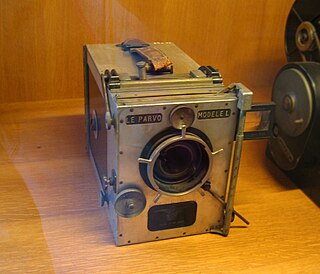 W
WThe Parvo was a 35mm motion picture camera developed in France by André Debrie. The patent was registered in 1908 by his father, Joseph Dules Debrie. The camera was relatively compact for its time. It was hand-cranked, as were its predecessors. To aid the camera operator in cranking at the correct speed, the camera had a built in tachometer.
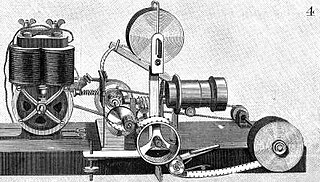 W
WThe Phantoscope was a film projection machine, a creation of Charles Francis Jenkins and Thomas Armat. In the early 1890, Jenkins began creating the projector. He later met Thomas Armat, who provided financial backing and assisted with necessary modifications The two inventors unveiled their modified projector at the Cotton States Exposition in Atlanta, Georgia, in September 1895.
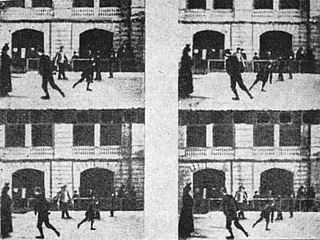 W
WPleograph was an early type of movie camera constructed in 1894, before those made by the Lumière brothers, by Polish inventor Kazimierz Prószyński.
 W
WA pocket video camera is a tapeless camcorder that is small enough to be carried in one's pocket.
 W
WA scan line is one line, or row, in a raster scanning pattern, such as a line of video on a cathode ray tube (CRT) display of a television set or computer monitor.
 W
WA sound blimp is a housing attached to a camera which reduces the sound caused by the shutter click, particularly SLRs. It is primarily used in film still photography, so as not to interfere with the shooting of principal photography, and also in other situations where sound is distracting: theatrical photography, surveillance, and wildlife photography.
 W
WSpydercam is a cable-suspended camera system, and rigging system used in making motion pictures, television and at athletic stadiums. Using computer controlled winches to drive synthetic lines connected to a crane, truss or buildings to achieve multidimensional, repeatable movement. Spydercam is used as an alternative to other camera movement systems.
 W
WSteenbeck is a company that manufactures flatbed editors. Steenbeck is brand name that has become synonymous with a type of flatbed film editing suite which is usable with both 16 mm and 35 mm optical sound and magnetic sound film.
 W
WTechnocrane is a telescopic crane that is used in the film industry and in television production, currently manufactured and designed in Poland by Peter Adamietz. There are many different sizes available, from 10 ft to 100 ft. The camera is mounted on the remote head on the end of the crane and is moved by a camera operator at a control desk. The Technocrane can telescope at different speeds controlled by the operator. It allows camera moves that cannot be achieved using a jib arm and dolly, and the telescoping can be used to compensate for the camera moving in an arc called "arc compensation". Scorpio Technocranes by the manufacturers: Service Vision based in Barcelona, Spain for example: can programmed to be engaged to remove the natural arc by adjusting the telescoping arm to do a straight dolly move at a much quicker setup than a traditional dolly and track.
 W
WA telecompressor or focal reducer is an optical element used to reduce focal length, increase lens speed, and in some instances improve optical transfer function (OTF) performance. It is also widely known under the name “Speed Booster”, which is the commercial name of a line of telecompressors by the manufacturer Metabones. Popular applications include photography, videography, and astrophotography. In astrophotography, these qualities are most desirable when taking pictures of nearby large objects, such as nebulae. The effects and uses of the telecompressor are largely opposite to those of the teleconverter or Barlow lens. A combined system of a lens and a focal reducer has smaller back focus than the lens alone; this places restrictions on lenses and cameras that focal reducer might be used with.
 W
WR. W. Paul presented Britain's second film projector, and the first commercially produced 35mm projector, the Theatrograph, on 20 February 1896. It was first demonstrated at Finsbury Technical College. The use of Paul's Theatrograph in music halls up and down the country popularised early cinema in Britain. It was first revealed to the public at the Egyptian Hall in Piccadilly, London.
 W
WVideo pointer is a device used to highlight or mark a specific location on a video display. The device is often equipped with a video input and output ports and a joystick to manipulate the motion of a pointer-cursor. Video pointers utilize video overlay technology to superimpose an image of a pointer-cursor over another video stream. Video pointers may also be equipped with other features such as selection of the type and shape of the cursor, image intensity control, and cursor size and color control.
 W
WA wet-transfer film gate, or wet gate for short, is a film gate that is submerged in liquid, used for film restoration and archival scanning. Submerging the film in the gate in a liquid with a suitably matched refractive index reduces the effects of scratches on the film, by reducing the refractive effects which divert light that passes through the scratched part of the film. The liquid also acts to lift other forms of defects from the film. Perchloroethylene, a hazardous substance with multiple health and safety risks, is commonly used as the liquid medium in wet gate systems, requiring substantial precautions to be taken to ensure the safety of operators and to prevent pollution.